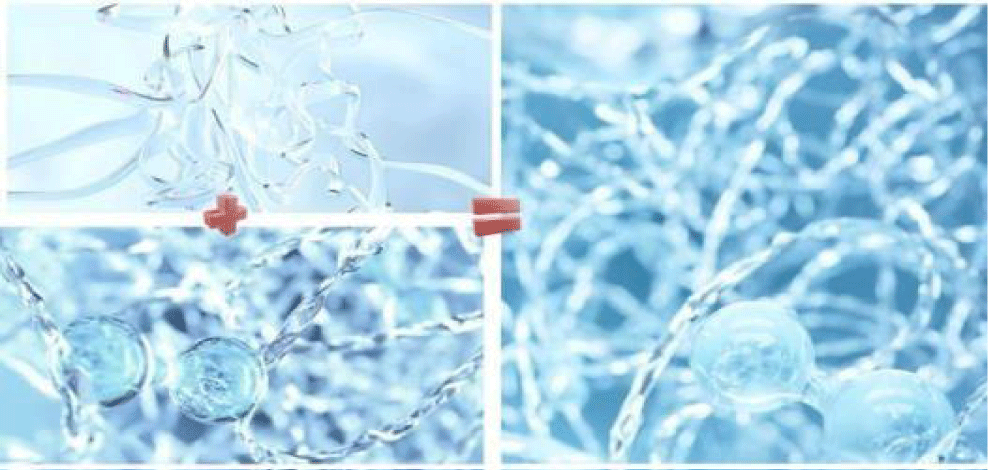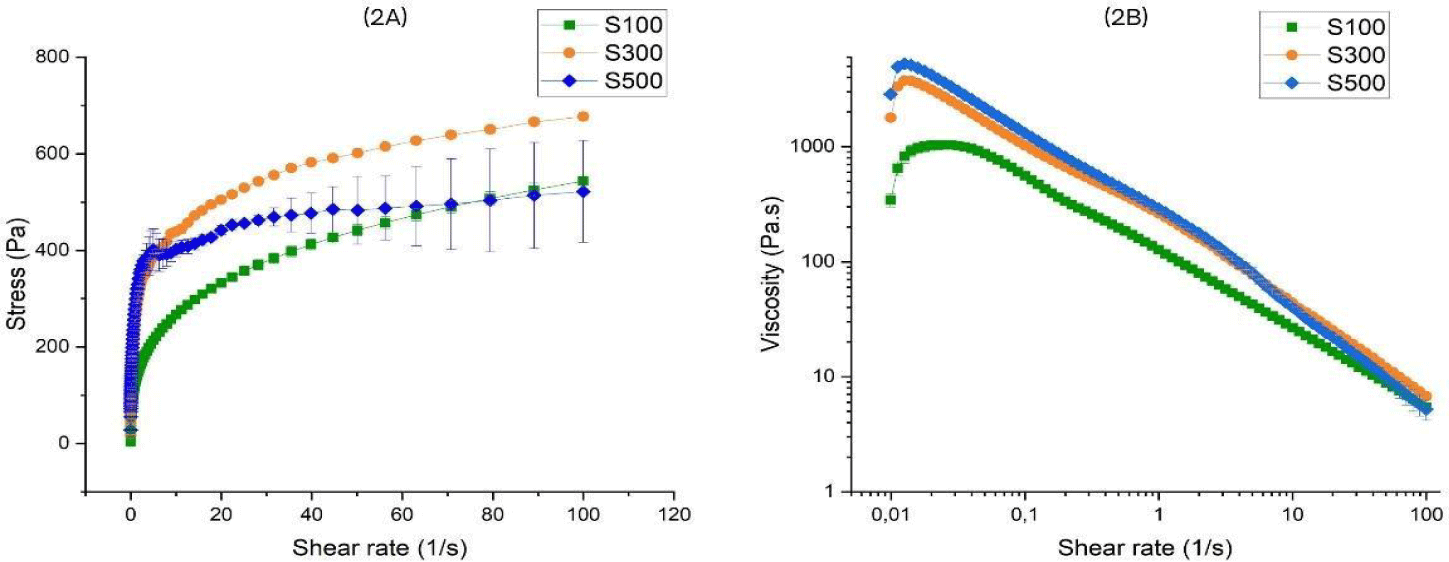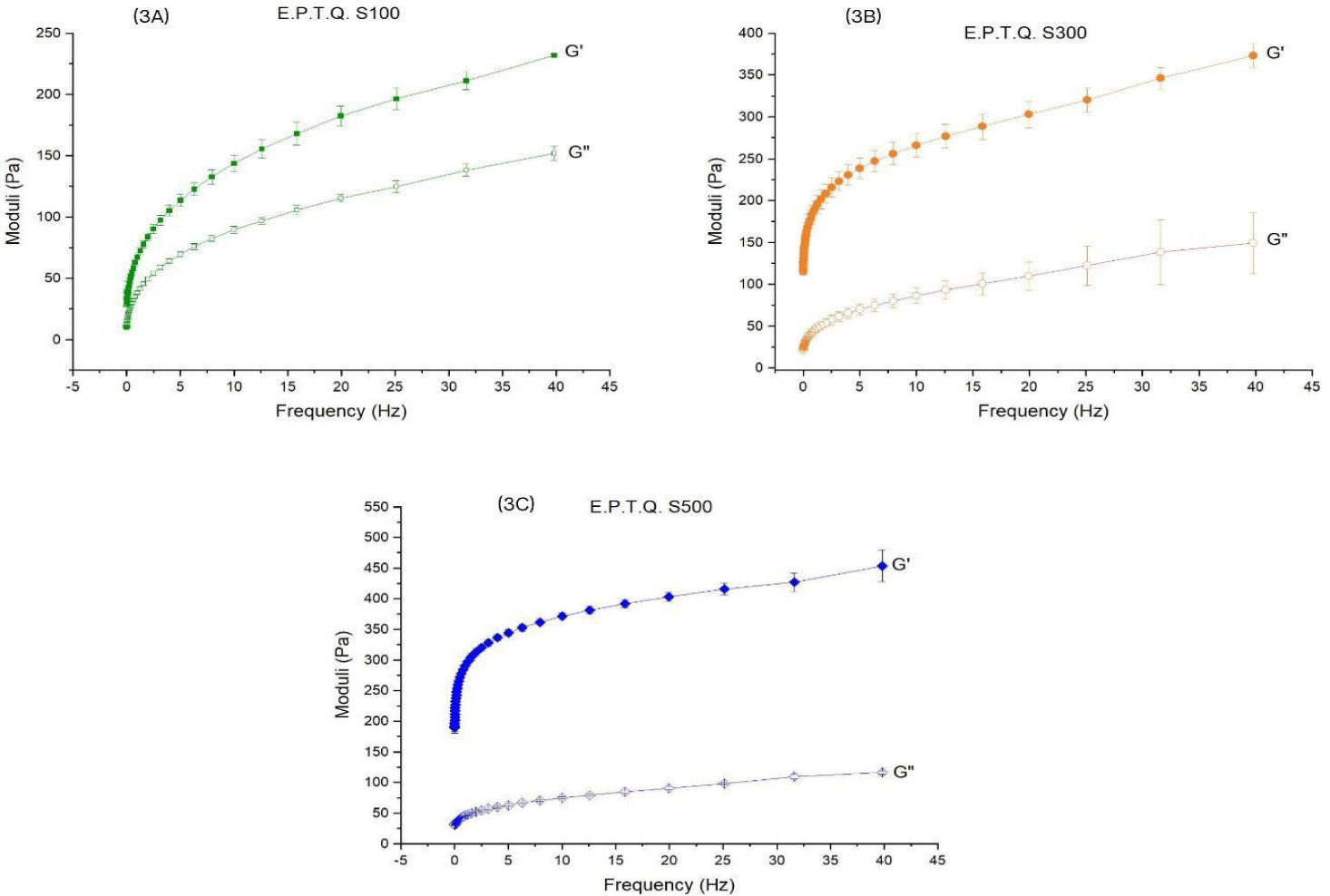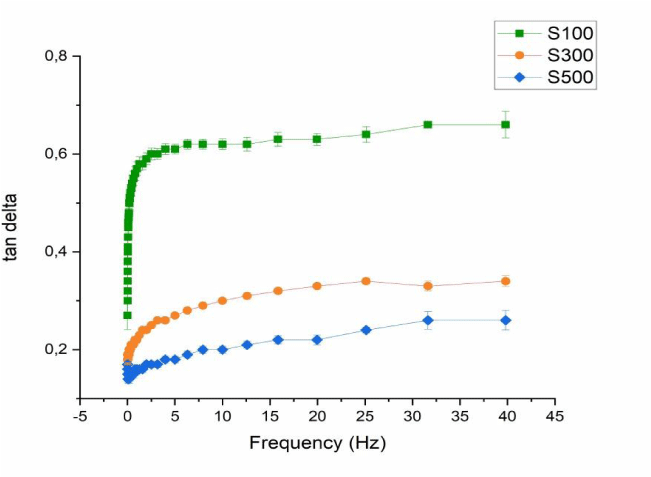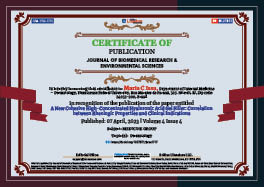Medicine Group . 2023 April 07;4(4):614-618. doi: 10.37871/jbres1717.
A New Cohesive High-Concentrated Hyaluronic Acid Gel Filler: Correlation between Rheologic Properties and Clinical Indications
Maria C Issa1*, Andreia Fogaca2, Eliandre Palermo2, Marina Fontes3, Hernane S Barud3 and Alessandra C Dametto4
2Private Office. Av. São Gualter, 1036- Alto Pinheiros, Zip code: 05455-00, Sao Paulo, Brazil
3University of Araraquara, Rua Carlos Gomes, 1217. Araraquara, Zip code: 14801-340, Sao Paulo. Brazil
4Biosmart Nanotechnology LTDA, Araraquara, Avenida Jorge Fernandes de Mattos 311. Box 4. Araraquara. Zip code: 14808-162, Sao Paulo, Brazil
- Rheology
- Rheologic properties
- Hyaluronic acid gel
- >Filler
- >Cosmetic
- >Rejuvenation
Abstract
Background: Differences among the Available Hyaluronic (HA) gels are relevant to clinical practice as the HA physicochemical characteristics guide cosmetic indications. Besides, the literature still needs more information about the correlation between the HA gel’s behavior through their rheologic parameters and clinical indications.
Objectives: We aim to evaluate the rheological properties of three gels with high concentrations of HA, e.p.t.q. S100®, S300®, and S500® (Jetema®) and extrapolate the results to their behavior after applied to the skin.
Methods: To correlate the physicochemical properties of e.p.t.q. gels to their possible clinical indications, three presentations of these gels were evaluated. The storage modulus (G’), loss modulus (G”), tan δ, complex modulus, viscosity, and cohesiveness were measured by rheology.
Results: The gels were non-Newtonian fluid with pseudoplastic behavior. All of them presented as elastic liquids (G’>G”). The S500 gel showed the highest G’ and complex modulus. S100 gel showed the highest tan δ and cohesiveness. S300 gel showed intermediary properties with tan δ and viscosity similar to the S500.
Discussion: Due to the high G’ and low tan δ, S500 gel is indicated for facial structuring and lifting. On the opposite, low G’ and high tan δ of S100 gel signal for refinement. The intermediate values of the S300 point it to lift or refinement.
Conclusions: According to the rheological results, we can assume that each gel has a specific indication, and the combination of S500, S300, and S100 enables a global facial treatment.
Introduction
Hyaluronic Acid (HA) is a polysaccharide (glycosaminoglycan) that repeats D-glucuronic acid and N-Acetyl-D-glucosamine disaccharide units and is the most abundant glycosaminoglycan in the extracellular matrix of human tissue. It exhibits poor biomechanical properties in its natural state and is cleared rapidly when injected into normal skin. Chemical modification is required to improve mechanical properties [1]. The addition of cross-linkers creates a three- dimensional network and a firmer gel that can resist degradation. The most common crosslinker molecule is 1,4-Butanediol Diglycidyl Ether (BDDE). Other interactions are weaker chemical bonds, such as hydrogen bonds or entanglements (mechanical interlocking), referred to as the natural crosslinks process [2].
The crosslinking reaction results in a gel block, which must be sized to pass through fine bore needles. Sizing is a process referred to as gel calibration. It can be accomplished by passing the gel mass through a series of sieves. An alternative way to size a large gel mass is to break it down through homogenization [1,3].
HA dermal filler is the most widely used agent for dermal filling. Specific physicochemical properties of HA gel are required to fill, volumize, sustain, and contour different anatomical areas and layers. Ideally, HA gels should have a similar consistency as the surrounding tissue to be injected to achieve a natural touch. Besides, it must sustain its shape against constant physical strain caused by muscle contraction. The high degree of crosslinking reduces the hydrophilicity of the HA and increases its hardness [4]. Gel hardness relates to its resistance to being deformed. It varies with HA concentration, crosslinking degree, and particle size. Generally, softer gels are indicated to fill superficial layers and are not usually meant to perform lifting or volumizing, for which stiffer gels are proposed [5,6].
Three main properties determine the filler performance under shear and compression/stretching forces: viscoelasticity, viscosity, and cohesivity. Viscoelasticity is a property of HA fillers that exhibits viscous and elastic behavior when undergoing shear deformation. Four rheological parameters describe this property [3,4].
‣G’ (storage or elastic modulus): measures elastic properties, representing the energy fraction of G* stored by the gel and used to recover the original shape.
‣G” (loss or viscous modulus): measures viscous properties, representing the energy fraction of G* lost on shear deformation through internal friction.
‣Tan δ measures the ratio between viscous and elastic properties. The lower Tan δ is associated with higher elasticity.
‣G* (complex modulus) that measures overall viscoelasticity or hardness. It represents how difficult it is to alter the shape of the filler.
Viscosity measures a filler’s resistance to flow when shear stress is applied. It affects the extrusion force. Highly viscous filler requires a high extrusion force. The viscosity of a dermal filler and the extrusion forces are related to the degree of crosslinking, the average gel particle size, and the manufacturing process itself [1].
Cohesivity is a property HA fillers exhibit when undergoing deformation compression/stretching forces and represents the energy that keeps a spatial HA particle distribution. This energy is a relative strength that induces the three- dimensional structure of the HA gel. It depends on the distance between the particles and, consequently, on the concentration of the solid immersed in the fluid phase. So, this attractive force is responsible for the HA particular distribution as an aggregated state, such as flocculated, coagulated, and clustered systems [7,8]. Different methods can measure the cohesiveness of the gels, such as compression force, dispersion in water, and drop weight, causing difficulty in comparing the results. The cohesive energy (Ecoh) can be calculated through the rheometer by the parameters that characterize the transition between the linear and non-linear regions (Eq. 3). This transition point is called "critical strain" (γcrit) when the elastic modulus value in the linear viscoelastic region (G' VLR) starts to decrease. Therefore, the Ecoh is a volumetric energy calculated per unit of volume (J m-3) [8].
HA gels are constantly subjected to intrinsic force due to tension and muscle and soft tissue movements above the bone. Furthermore, extrinsic force sources induce compression/stretching and lateral shearing from daily activities. Therefore, not just the viscoelasticity matters; the cohesivity is also critical for HA gel performance [9]. The cohesive energy is vital to characterize how the filler behaves after being implanted. Low cohesiveness makes it easier for the particles to separate, and the gel deposited on the skin would lose shape and spread after repetitive compression forces on the face. HA filler with lower cohesivity has weaker adhesion forces and tends to lose projection easier than a filler with higher cohesivity and equivalent G’ [10].
A new Korean homogenous HA gel, e.p.t.q, is now available in Brazil. It is a cohesive high-concentrated (24 mg/ml) HA gel with dual (physical and chemical) crosslinking technology and the same particle size in all three presentations (S100, S300, S500) (Data from Jetema®) (Figure 1). We aim to analyze the rheological properties of these three gels and extrapolate the results to clinical practice.
Materials and Methods
The rheological study was conducted at BioSmart Nanotechnology Laboratory (Araraquara- SP, Brazil). An AR-1500ex rheometer (TA Instruments, New Castle, NE, USA) measuring system with a gap of 500 µm at 25°C and sandblasted parallel plat geometry (40 mm diameter) was used. The shear rate ranges from 0.01 to 100s-1. Three types of e.p.t.q.® gel (Jetema, Korea), e.p.t.q. S100, e.p.t.q S300, and e.p.t.q S500 with the same HA concentration (24 mg/ml) and the same particle size were evaluated. All analyses were performed in triplicate.
The storage modulus (G’), loss modulus (G”), tan δ, and complex modulus were calculated directly from the AR-1500ex rheometer. The viscosity was analyzed through the rheological flow sweep, and the cohesiveness was calculated through the transition point (γcrit) in the Linear Viscoelastic Region (LVE) by the average strain value (Eq. 3).
Results
All e.p.t.q. gels exhibit a nonlinear curve, being non-Newtonian fluids (Figure 2A) with pseudoplastic behavior as the viscosity decreases while the shear rate increases (Figure 2B).
Storage moduli (G’) of e.p.t.q. S500, S300, and S100 gels were higher than loss moduli (G”) (Figures 3A-C). The tan δ values of S500, S300, and S100 were less than 1 (Figure 4).
The cohesiveness energy of S500, S300, and S100 were 642 J m-3, 35,674 J m-3, and 209,240 J m-3, respectively.
The physicochemical properties of the three gels studied are summarized in table 1.
| Table 1: Physicochemical properties of e.p.t.q. hyaluronic acid gels. | |||||
| Product | G’ (Pa) | G” (Pa) | tan δ | Complex modulus | Viscosity (Pa.s) |
| 0.1 Hz | 1 (1/s) | ||||
| e.p.t.q S100 | 36 ± 2 | 16 ± 1 | 0.46 ± 0.02 | 39 ± 2 | 127 ± 5 |
| e.p.t.q S300 | 144 ± 9 | 28 ± 1 | 0.19 ± 0.01 | 146 ± 9 | 263 ± 7 |
| e.p.t.q S500 | 232 ± 9 | 33 ± 1 | 0.14 ± 0.01 | 234 ± 9 | 288 ± 7 |
Discussion
Gel hardness relates to its resistance to being deformed. It varies with HA concentration, crosslinking degree, and particle size [6]. All three gels have the same HA concentration and particle size, varying their crosslinking degree. The S500 gel has a high G’ and complex modulus and low tan δ. As reported in the literature, these characteristics are essential for structure, contour, and facial lifting [4].
It is known that gels with higher G’ values present lower cohesivity. On the contrary, gels with lower G’ values have higher cohesivity. This information is valid for gels with 20 mg/mL or more HA [7]. In our study, we measured the cohesive energy through the rheometer based on the G’, corroborating Edsman, et al. [7]. On the other hand, we cannot compare our results to other previous reports because cohesiveness was measured through other methods [7,8,11]. Despite this, e.p.t.q. S500, which has the highest G’, compared to S300 and S100, maintained high cohesiveness compared to other HA gels in the market (Restylane® and Juvederm volbella®), reported by Lee, et al. [11]. The combination of high G’ and cohesiveness is essential to promote structure and lift, avoiding spreading after repetitive compression forces in the face, mainly when the gel is applied deeply [1].
The S100 has low G’ and high tan δ, considered a softer gel, being indicated for superficial layer application for refinement [2,4]. The S100 differs from other HA gels with low G’ in the market, as it has a high HA concentration [3,4].
The S300 gel showed intermediary properties regarding viscoelasticity and cohesivity. As the tan δ value is similar to the S500 gel, it can also be indicated for lifting. Its ability not to spread easily makes it a good indication for filling the frontal region [11].
Conclusion
E.p.t.q.® gels vary in physicochemical properties, mainly in their G’ and cohesiveness. Extrapolating the rheological results for clinical indications, we attribute the S500 to deep structuring, contouring, and lifting, the S100 for superficial refinement, and the S300 for filling, volume, and lifting, depending on the facial structure and laxity.
References
- Pierre S, Liew S, Bernardin A. Basics of dermal filler rheology. Dermatol Surg. 2015 Apr;41 Suppl 1:S120-6. doi: 10.1097/DSS.0000000000000334. PMID: 25828036.
- Zerbinati N, Capillo MC, Sommatis S, Maccario C, Alonci G, Rauso R, Galadari H, Guida S, Mocchi R. Rheological Investigation as Tool to Assess Physicochemical Stability of a Hyaluronic Acid Dermal Filler Cross-Linked with Polyethylene Glycol Diglycidyl Ether and Containing Calcium Hydroxyapatite, Glycine and L-Proline. Gels. 2022 Apr 23;8(5):264. doi: 10.3390/gels8050264. PMID: 35621562; PMCID: PMC9140203.
- Kablik J, Monheit GD, Yu L, Chang G, Gershkovich J. Comparative physical properties of hyaluronic acid dermal fillers. Dermatol Surg. 2009 Feb;35 Suppl 1:302-12. doi: 10.1111/j.1524-4725.2008.01046.x. PMID: 19207319.
- Fagien S, Bertucci V, von Grote E, Mashburn JH. Rheologic and Physicochemical Properties Used to Differentiate Injectable Hyaluronic Acid Filler Products. Plast Reconstr Surg. 2019 Apr;143(4):707e-720e. doi: 10.1097/PRS.0000000000005429. PMID: 30921116; PMCID: PMC7597953.
- Carruthers J, Carruthers A, Humphrey S. Introduction to Fillers. Plast Reconstr Surg. 2015 Nov;136(5 Suppl):120S-131S. doi: 10.1097/PRS.0000000000001770. PMID: 26441092.
- Borrell M, Leslie DB, Tezel A. Lift capabilities of hyaluronic acid fillers. J Cosmet Laser Ther. 2011 Feb;13(1):21-7. doi: 10.3109/14764172.2011.552609. Epub 2011 Jan 21. PMID: 21254807.
- Edsman KLM, Öhrlund Å. Cohesion of Hyaluronic Acid Fillers: Correlation Between Cohesion and Other Physicochemical Properties. Dermatol Surg. 2018 Apr;44(4):557-562. doi: 10.1097/DSS.0000000000001370. PMID: 29059137; PMCID: PMC5902128.
- Megías-Alguacil D. Characterization of the Linear Viscoelastic Region in Suspensionsof Zirconium Oxide: Cohesive Energy Obtained From the Critical Parameters. Applied Rheology. 2004;14:126-132.
- Cotofana S, Hamade H, Bertucci V, Fagien S, Green JB, Pavicic T, Nikolis A, Lachman N, Hadjab A, Frank K. Change in Rheologic Properties of Facial Soft-Tissue Fillers across the Physiologic Angular Frequency Spectrum. Plast Reconstr Surg. 2021 Aug 1;148(2):320-331. doi: 10.1097/PRS.0000000000008188. PMID: 34398083.
- Heitmiller K, Ring C, Saedi N. Rheologic properties of soft tissue fillers and implications for clinical use. J Cosmet Dermatol. 2021 Jan;20(1):28-34. doi: 10.1111/jocd.13487. Epub 2020 Aug 7. PMID: 32413205.
- Won Lee, Jh-Y, Ik-Soo Koh, Wook Oh, Ki-Wook Kim, Eun-Jung Yang. Clinical application of a new hyaluronicacid filler based on its rheologicalproperties and the anatomical site of injection. Biomedical Dermatology. 2018.
Content Alerts
SignUp to our
Content alerts.
 This work is licensed under a Creative Commons Attribution 4.0 International License.
This work is licensed under a Creative Commons Attribution 4.0 International License.





